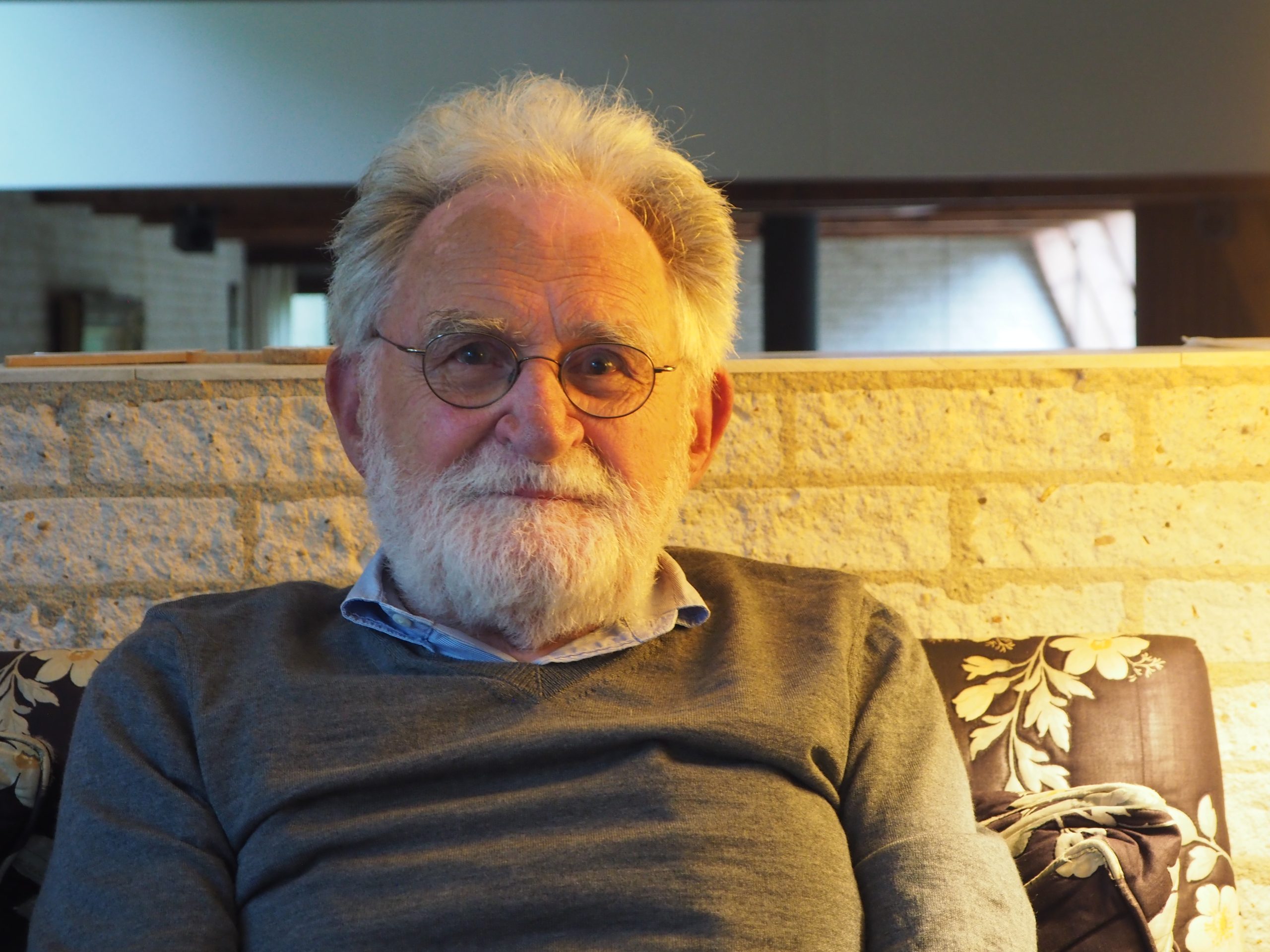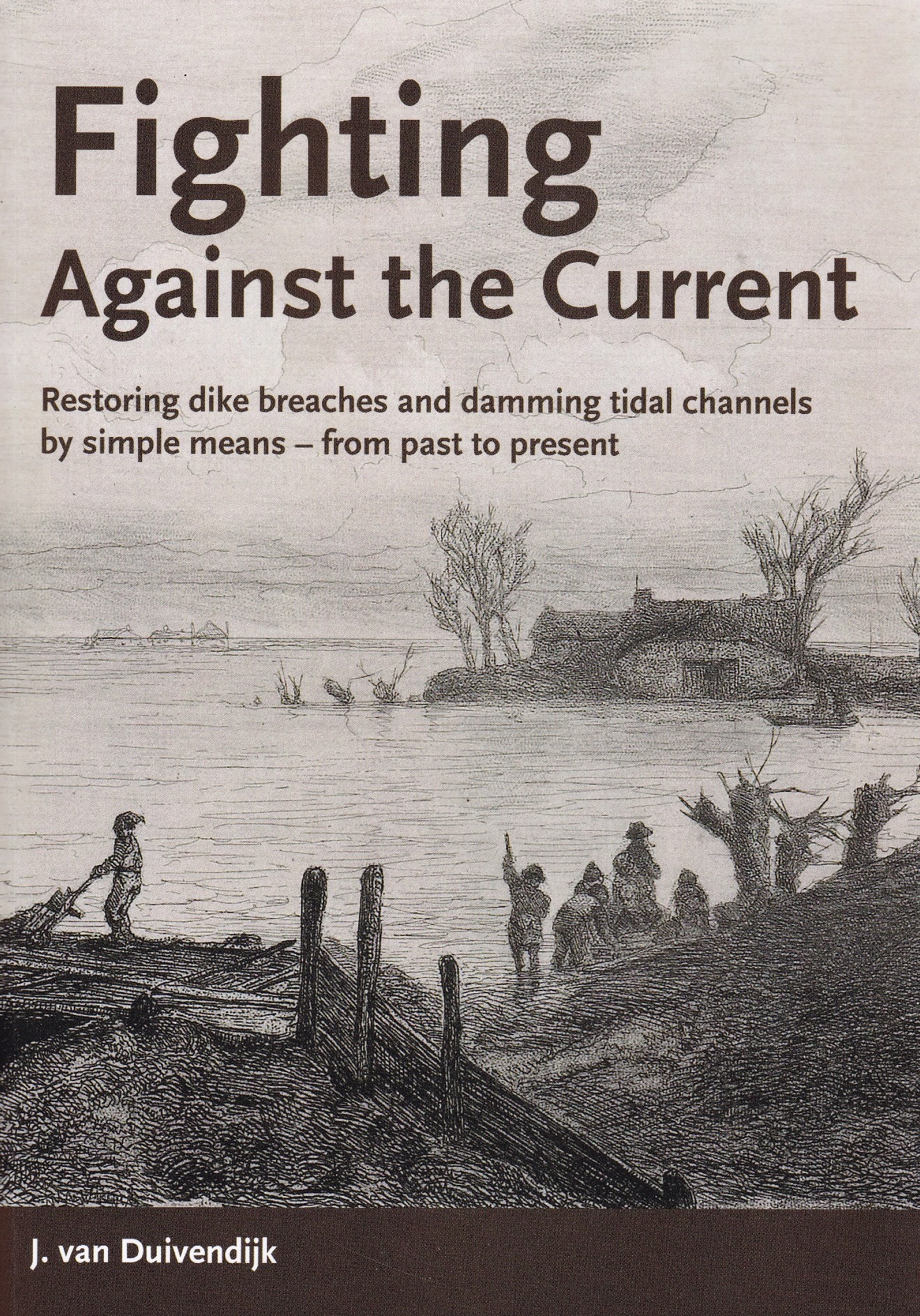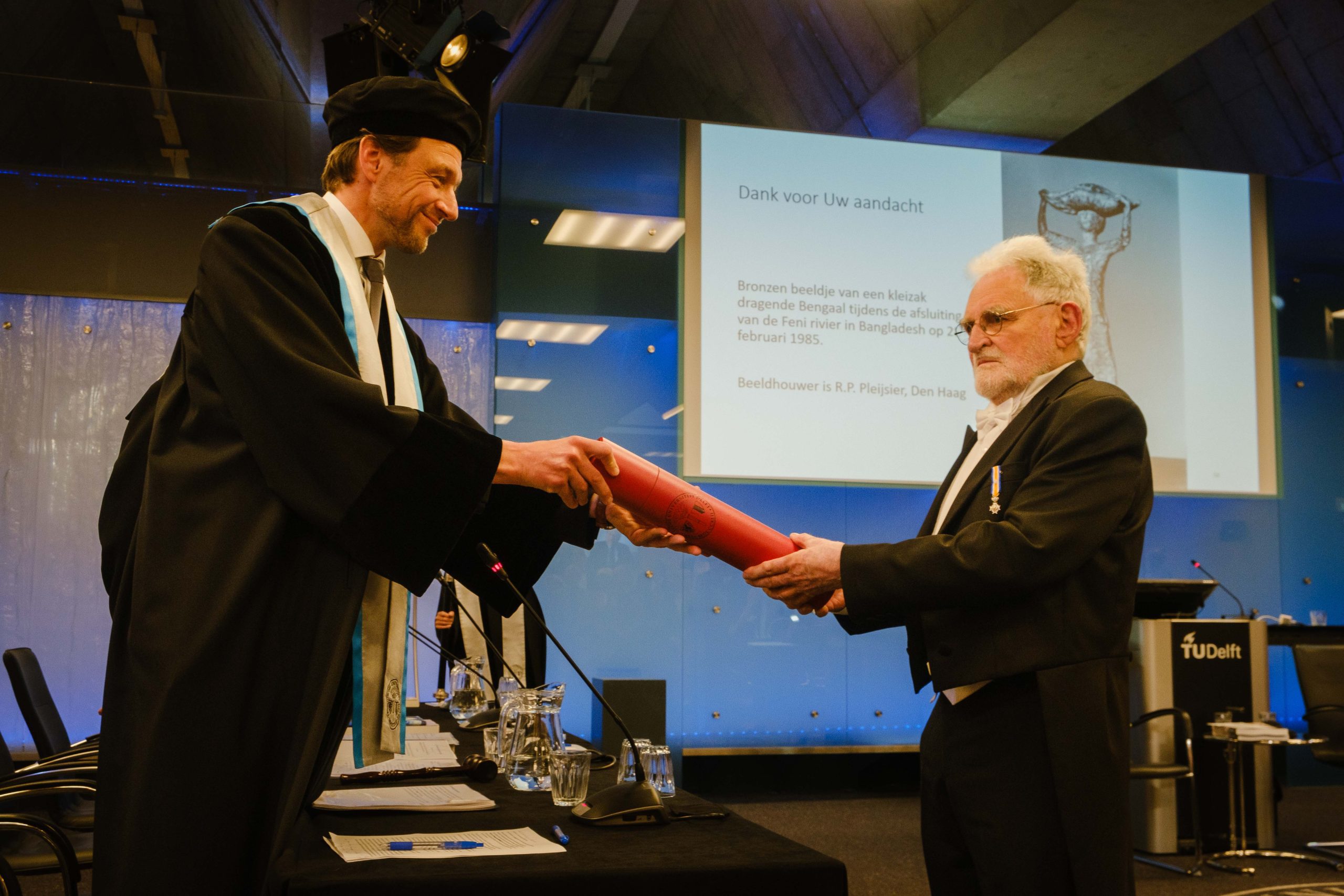He is probably the oldest PhD student at TU Delft ever. Hans van Duivendijk was 89 when he defended his PhD thesis on the ongoing battle against water on 17 June. As an engineer, he was able to use simple means to build complex water management systems in countries such as Bangladesh, Ghana and Nigeria.
Supervisor Bas Jonkman (left) presents the doctoral degree to Dr Hans van Duivendijk. (Photo: Jaden Accord)
Hans van Duivendijk was born in 1934 into a family of ship builders in Zierikzee. When still young, he decided not to follow in the footsteps of his father, but to study civil engineering at the then TH Delft. What made him take this decision?
“To the outside world, I said I wanted to do applied mathematics because I was good at it,” Van Duivendijk says in his living room in Nijmegen. “People would nod approvingly. But actually, I wanted to become an engineer like John Wayne in the film Tycoon. I saw the film when I was 14 years old. Wayne plays an American engineer who has to build a railway tunnel in South America. But it went completely wrong. He then built a bridge, but it too threatened to collapse. He saved the bridge by putting a train on top of it to weigh it down. I immediately wanted to do that. I wanted to become an engineer!” Four years later, in the summer of 1952, Van Duivendijk moved from Zierikzee to Delft.
North Sea flood
He had barely started his studies when the dykes broke in Zeeland, South Holland and Brabant on 1 February 1953, which became known as the North Sea flood. Even around his parental home in Zierikzee (his parents had moved to Terneuzen a year and a half earlier), there was up to one and a half metres of water. The sea dyke had breached in three places and the sea water flowed through freely at every ebb and flow. Professor Jansen (link in Dutch) introduced him to the Zuiderzeewerken group, which had been sent to Zeeland to help.
Van Duivendijk explained what happened next. “I then spent two months there watching them seal the tidal inlets. At first I helped a lot, but later I started making notes. They made a fascine mattress out of brushwood. This is a kind of floating mattress that is towed to the site at high tide. It is then lashed between four large barges and ballasted – loaded with stones – until it hangs like a sack between the boats. When the tide turns, they simultaneously cast off the fastening and the mattress loaded with stones sinks straight to the bottom. I don’t think anyone can do that now.”
Residents made a hole in a lagoon but couldn’t close it again
After studying hydraulic engineering, the obvious choice for him was to work at the Dutch Delta Works, but he was more attracted to working abroad. Most of the work abroad was through engineering firms, so in 1960 Van Duivendijk, after doing his military service, applied for a job at Van Hasselt en De Koning, later Royal HaskoningDHV. After first working in the Netherlands for four years, he got the chance to work on the construction of a dam on the Niger River in Nigeria. For four years he coordinated the technical contributions from different countries. “It was a World Bank project so the transformers came from Sweden, the crane from Canada, the turbines from England, and the sliders and pipes from Austria. And it all had to fit together.”
Sleeping mats with sand
His second big job, in Ghana in 1970, was pure hydraulic engineering. Residents had made a hole in a lagoon because of standing water, but were unable to close it. “I was asked to advise on how they could plug that hole,” he says.
Sand dredgers were not available, so Van Duivendijk decided to use road construction equipment to close the hole from two sides as far as possible and then close the last part with sandbags. This technique was done in some places in Zeeland in 1953.
“We then made mattresses from sleeping mats and ballasted them with sandbags. On the last day, we worked with 40 local fishermen and 300 students to close the hole for good. Working together, it took four students to drag one full sandbag over the embankment to the hole. The fishermen, standing in the hole, picked up the bags, threw them into the water and stood on them. But while we had counted on a neap tide with still water, a sea wind started to blow which pushed a lot of water through the hole. Luckily the fishermen could swim well and were not afraid of the water, so we closed the hole in five hours.”
Old Dutch hydraulic engineering techniques
An even bigger job awaited him in 1985 in present-day Bangladesh. The job there was to seal the mouth of the Feni river to create a freshwater lake for irrigation and as flood protection from the sea. Van Duivendijk made the design for Royal HaskoningDHV, which became a combination of old Dutch hydraulic engineering techniques with materials and manpower from Bangladesh. Dutch television made a documentary about it.
Is it going well, a reporter asked? It is going excellently, the engineer replied
For the smaller creeks that needed to be closed, Van Duivendijk used mattresses made of bamboo, palm leaves and reeds. These were towed to their designated location and gradually filled with ballast. A sill was built by dumping clay clods on top of the bottom protection at the level of the low tide. The final closure had to be done within one tide, starting at low tide. Ten thousand workers had been employed to dump stones and bags of clay on the sill fast enough to stay ahead of the rising sea water.
Van Duivendijk recalls, “One of the engineers was watching the teeming mass of workers from the shore. ‘Are things going well?’, a reporter asked. ‘Things are going excellently,’ the engineer replied. ‘I had assumed that they would walk one metre per second with a bag on their heads, but they are walking two metres per second. So it’s going to be absolutely fine.’ That, of course, is a typical engineer’s answer.”
Associate Professor
Based on his exceptional practical experience, he became a partner at Royal HaskoningDHV and Associate Professor of Energy Hydrology at TU Delft (1986-2009). In 2016, after years of archival work, he published a book called Their own boss, the Shipyards of the Van Duivendijk Family (link in Dutch) about his forefathers’ 35 shipyards. In the book, Van Duivendijk names a few characteristic family traits: ‘independence, great craftsmanship and a lot of perseverance’.
That he is not entirely free of those traits himself became apparent when, in 2018, he pursued a PhD on the history of simple ways to repair dike breaches and close tidal channels. ‘We thought this was a thing of the past,’ writes his PhD supervisor Prof. Bas Jonkman (Faculty of Civil Engineering and Geosciences) about it. ‘But in Bangladesh, it turned out that (on behalf of) the World Bank, people were still doing this in abundance.’
‘They assume we are all students’
Partly due to health problems, the PhD research took longer than the allotted four years. This created friction with the TU Delft Graduate School, which is not well adapted to older PhD students. “It’s a colossal bureaucracy, that Graduate School,” is Van Duivendijk’s view. “They assume we are all students. Then a secretary sends me another letter saying ‘Dear Hans’. What do you mean ‘Dear Hans’? I don’t even know this lady.”
His next big project will be the triage of his 100 metres of books and binders. Moving to a flat, urged by his children, is gradually becoming inevitable. But that means that three-quarters of his archive will have to go.
He is attracted to a new flat in the monumental Estel building overlooking the river Waal. The building used to house Royal HaskoningDHV. “The boss would come by and say ‘you are not paid to look out of the window here’,” Van Duivendijk recalls. “But now, of course, I can.”



Fighting against the current – restoring dike breaches and damming tidal channels by simple means – from past to present.
In past centuries, people developed various ways to seal dyke breaches and dam tidal channels. These closure methods were needed to repair damage after floods or to reclaim land. The closures were carried out by simple means such as using local materials, simple equipment and manual labour.
TV documentary on the closure of the river Feni in Bangladesh with stones and manpower
Do you have a question or comment about this article?
j.w.wassink@tudelft.nl


Comments are closed.